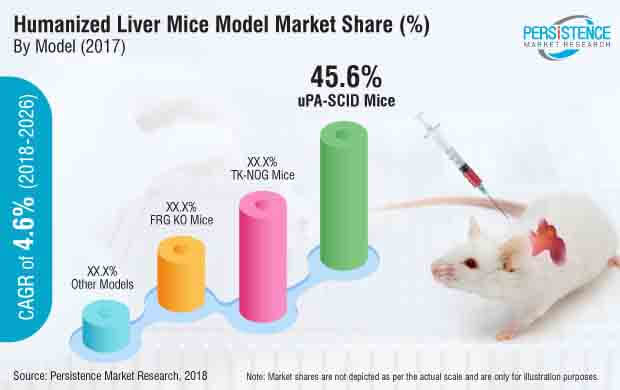The Humanized Liver Mice Model Market is all set to hack the digital turbulence frequency In Upcoming Years. Digital technologies are the transformation of legacy approaches to contemporary approaches. With an ever-increasing demand for real-time, precise, and instant response from the data for creating new-fangled services and products, or exchanging the ones that exist, and formulating novel business models, digital transformation is there to witness a geometric progression in every vertical in the upcoming period.
A large number of humanized liver mice models are available, including uPA-SCID mice, FRG KO mice, and TK-NOG mice, among others. Factors such as increasing incidence of liver cirrhosis, technological advancement and development of new humanized liver mice models, increase in number of FDA approvals for liver-based disease treatment dugs have increased the number of research and development activities, which require these models. However, the high cost of mice models as well as high shipping cost, and availability of alternatives are factors expected to hinder the growth of the humanized liver mice model market during the forecast period.
Get Sample Copy of this Report@ https://www.persistencemarketresearch.com/samples/25417
Furthermore, regulatory challenges including patenting of mice and other ethical issues including the use of 3Rs policy are also expected to restrain the growth of the humanized liver mice model market. The global humanized liver mice model market is projected to account for over US$ 22.8 Mn in terms of value by 2026 end, according to a latest research by PMR. The report on the global humanized liver mice model market further projects significant growth potential with average year-on-year growth rate of 4.6% through 2026.
Company Profiles:
- Taconic Biosciences, Inc.
- Beijing Vitalstar Biotechnology Co., Ltd.
- Yecuris Corporation
- PhoenixBio Group
- In-Vivo Science Inc.
- The Jackson Laboratory
- University of Massachusetts Medical School(Mueller Lab)
- Oncodesign
- University of Nebraska Medical Center
- Others.
Request for Methodology@ https://www.persistencemarketresearch.com/methodology/25417

Albumin enhancer/promoter-driven urokinase-type plasminogen and activator/severe combined immunedeficient mice are known as the uPA-SCID mice. These mice suffer from a transgene-induced liver disease, and are transplanted with primary human hepatocytes immediately after birth. These mice were one of the first humanized liver mice model developed with high chimerism and are the most common type of humanized liver mice models available. The TK-NOG mice are designed to express a Herpes Simplex Virus-1 Thymidine Kinase (HSVtk) transgene that is primarily driven by the albumin enhancer/promoter in the liver of the mice. This induces liver-specific injury when treated with gancyclovir.
Human liver cells are then introduced into the liver of the mouse to replace the liver cells that are destroyed. The other type of humanized liver mice model that is gaining popularity is the FRG KO mice. The FRG KO mice are developed by knocking out three genes including Fah-/-; Rag2-/-; and Il2rg-/-. These mice overcome some of the drawbacks of the uPA-SCID mice such a low breeding capacity and genotype reversion. These mice have a slightly better breeding capacity and cannot undergo genotype reversion allowing the human hepatocytes to be serially transplanted into other mice. These humanized liver mice models also show high chimerism like the uPA-SCID mice.
Access Full Report@ https://www.persistencemarketresearch.com/checkout/25417
PMR has segmented the global humanized liver mice model market based on model, application, end user and region. The humanized liver mice model by model is further sub-segmented into uPA-SCID Mice, FRG KO Mice, TK-NOG Mice, and other models. Based on end users, the humanized liver mice model market is segmented into pharmaceutical companies, biotechnology companies, CRO’s and academic & research institutes. CRO’s segment is expected to hold maximum share in the global humanized liver mice model market followed by academic &research institutes segment. Based on application, the humanized liver mice model market is segmented into pharmacokinetic studies, in-vivo liver toxicity testing, drug metabolism studies, and other applications.
North America is expected to be the dominant regional market for humanized liver mice model. This is due to the support for research activities by the government as well as private sectors. Government funding and support for patenting genetically modified mice are other factors that support the growth of the humanized liver mice model market in North America. China is also expected to be a lucrative regional market for humanized liver mice model due to the changing regulations of the government to support the pharmaceutical and biopharmaceutical industries in the region.
About Us:
Persistence Market Research is here to provide companies a one-stop solution with regards to bettering customer experience. It does engage in gathering appropriate feedback after getting through personalized customer interactions for adding value to customers’ experience by acting as the “missing” link between “customer relationships” and “business outcomes’. The best possible returns are assured therein.
Contact Us:
Persistence Market Research
Address – 305 Broadway, 7th Floor, New York City,
NY 10007 United States
U.S. Ph. – +1-646-568-7751
USA-Canada Toll-free – +1 800-961-0353
Sales – sales@persistencemarketresearch.com
Website – https://www.persistencemarketresearch.com